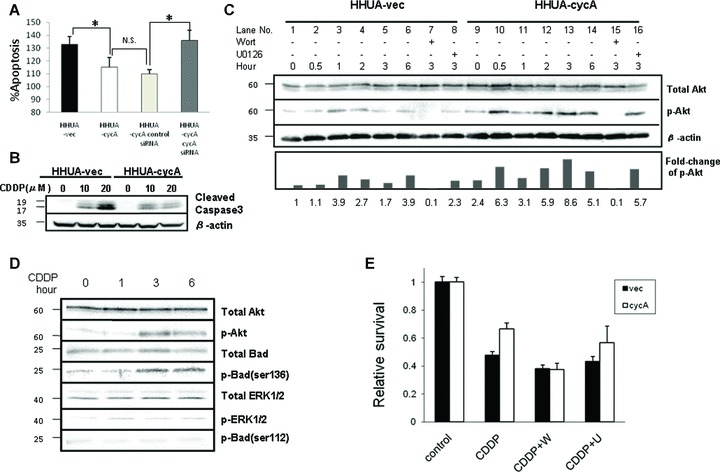Fig 4.

Cyclin A2 suppressed cisplatin-induced apoptosis via PI3K pathway. (A) Cisplatin-induced apoptosis (cisplatin 20 μM) detected by the ApoStrand method was decreased in HHUA-cycA cells compared with HHUA-vec cells. Transfection of siRNA for cyclin A2 into HHUA-cycA recovered the apoptosis to the level in HHUA-vec cells. The percentage of apoptotic cells was calculated using the value for control cells (N.S.: not significant; *P < 0.05). (B) Cisplatin treatment (20 μM) resulted in reduced expression of cleaved caspase-3 in HHUA-cycA cells after 48 hrs compared with vector-transfected cells. (C) Forced expression of cyclin A2 resulted in increased expression of p-Akt before the addition of cisplatin (20 μM) (lanes 1 and 9), and for 6 hrs after the addition (lanes 6 and 14) in HHUA-cycA cells compared with HHUA-vec cells. Wortmannin (W, 1 μM), but not UO126 (U, 1 μM), markedly reduced the expression of p-Akt. Five individual experiments indicated comparable results, and representative blots are shown. The lower graph indicates the relative intensities of p-Akt protein against total Akt protein quantified using densitometry. The value was mean from five individual experiments. (D) Cisplatin-induced Akt activation was associated with Bad phosphorylation at Ser 136 in HHUA-cycA cells, but not with ERK activation and Bad Ser 112 phosphorylation. (E) Cisplatin treatment reduced the number of viable cells among both HHUA-cycA2 cells and HHUA-vec cells, but the number of viable cells was larger for HHUA-cycA cells. Wortmannin (1 μM) treatment prior to cisplatin treatment abrogated the survival advantage against cisplatin in HHUA-cycA cells, but no such effect was observed on UO126 (1 μM) treatment (N.S.: not significant; *P < 0.05).
